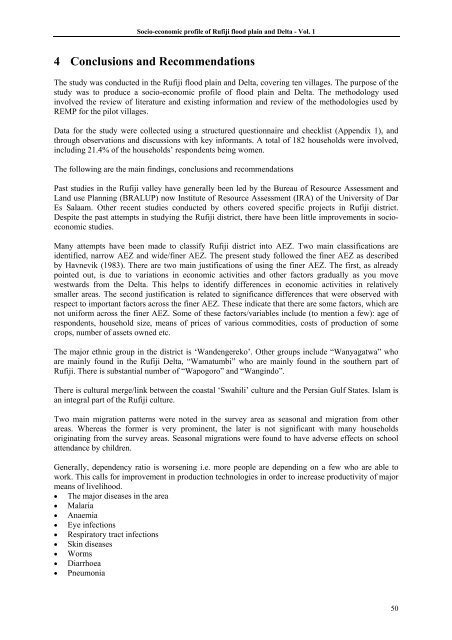A Socio-Economic Profile of the Rufiji Floodplain and Delta.
A Socio-Economic Profile of the Rufiji Floodplain and Delta.
A Socio-Economic Profile of the Rufiji Floodplain and Delta.
Create successful ePaper yourself
Turn your PDF publications into a flip-book with our unique Google optimized e-Paper software.
<strong>Socio</strong>-economic pr<strong>of</strong>ile <strong>of</strong> <strong>Rufiji</strong> flood plain <strong>and</strong> <strong>Delta</strong> - Vol. 1<br />
4 Conclusions <strong>and</strong> Recommendations<br />
The study was conducted in <strong>the</strong> <strong>Rufiji</strong> flood plain <strong>and</strong> <strong>Delta</strong>, covering ten villages. The purpose <strong>of</strong> <strong>the</strong><br />
study was to produce a socio-economic pr<strong>of</strong>ile <strong>of</strong> flood plain <strong>and</strong> <strong>Delta</strong>. The methodology used<br />
involved <strong>the</strong> review <strong>of</strong> literature <strong>and</strong> existing information <strong>and</strong> review <strong>of</strong> <strong>the</strong> methodologies used by<br />
REMP for <strong>the</strong> pilot villages.<br />
Data for <strong>the</strong> study were collected using a structured questionnaire <strong>and</strong> checklist (Appendix 1), <strong>and</strong><br />
through observations <strong>and</strong> discussions with key informants. A total <strong>of</strong> 182 households were involved,<br />
including 21.4% <strong>of</strong> <strong>the</strong> households’ respondents being women.<br />
The following are <strong>the</strong> main findings, conclusions <strong>and</strong> recommendations<br />
Past studies in <strong>the</strong> <strong>Rufiji</strong> valley have generally been led by <strong>the</strong> Bureau <strong>of</strong> Resource Assessment <strong>and</strong><br />
L<strong>and</strong> use Planning (BRALUP) now Institute <strong>of</strong> Resource Assessment (IRA) <strong>of</strong> <strong>the</strong> University <strong>of</strong> Dar<br />
Es Salaam. O<strong>the</strong>r recent studies conducted by o<strong>the</strong>rs covered specific projects in <strong>Rufiji</strong> district.<br />
Despite <strong>the</strong> past attempts in studying <strong>the</strong> <strong>Rufiji</strong> district, <strong>the</strong>re have been little improvements in socioeconomic<br />
studies.<br />
Many attempts have been made to classify <strong>Rufiji</strong> district into AEZ. Two main classifications are<br />
identified, narrow AEZ <strong>and</strong> wide/finer AEZ. The present study followed <strong>the</strong> finer AEZ as described<br />
by Havnevik (1983). There are two main justifications <strong>of</strong> using <strong>the</strong> finer AEZ. The first, as already<br />
pointed out, is due to variations in economic activities <strong>and</strong> o<strong>the</strong>r factors gradually as you move<br />
westwards from <strong>the</strong> <strong>Delta</strong>. This helps to identify differences in economic activities in relatively<br />
smaller areas. The second justification is related to significance differences that were observed with<br />
respect to important factors across <strong>the</strong> finer AEZ. These indicate that <strong>the</strong>re are some factors, which are<br />
not uniform across <strong>the</strong> finer AEZ. Some <strong>of</strong> <strong>the</strong>se factors/variables include (to mention a few): age <strong>of</strong><br />
respondents, household size, means <strong>of</strong> prices <strong>of</strong> various commodities, costs <strong>of</strong> production <strong>of</strong> some<br />
crops, number <strong>of</strong> assets owned etc.<br />
The major ethnic group in <strong>the</strong> district is ‘W<strong>and</strong>engereko’. O<strong>the</strong>r groups include “Wanyagatwa” who<br />
are mainly found in <strong>the</strong> <strong>Rufiji</strong> <strong>Delta</strong>, “Wamatumbi” who are mainly found in <strong>the</strong> sou<strong>the</strong>rn part <strong>of</strong><br />
<strong>Rufiji</strong>. There is substantial number <strong>of</strong> “Wapogoro” <strong>and</strong> “Wangindo”.<br />
There is cultural merge/link between <strong>the</strong> coastal ‘Swahili’ culture <strong>and</strong> <strong>the</strong> Persian Gulf States. Islam is<br />
an integral part <strong>of</strong> <strong>the</strong> <strong>Rufiji</strong> culture.<br />
Two main migration patterns were noted in <strong>the</strong> survey area as seasonal <strong>and</strong> migration from o<strong>the</strong>r<br />
areas. Whereas <strong>the</strong> former is very prominent, <strong>the</strong> later is not significant with many households<br />
originating from <strong>the</strong> survey areas. Seasonal migrations were found to have adverse effects on school<br />
attendance by children.<br />
Generally, dependency ratio is worsening i.e. more people are depending on a few who are able to<br />
work. This calls for improvement in production technologies in order to increase productivity <strong>of</strong> major<br />
means <strong>of</strong> livelihood.<br />
• The major diseases in <strong>the</strong> area<br />
• Malaria<br />
• Anaemia<br />
• Eye infections<br />
• Respiratory tract infections<br />
• Skin diseases<br />
• Worms<br />
• Diarrhoea<br />
• Pneumonia<br />
50
















